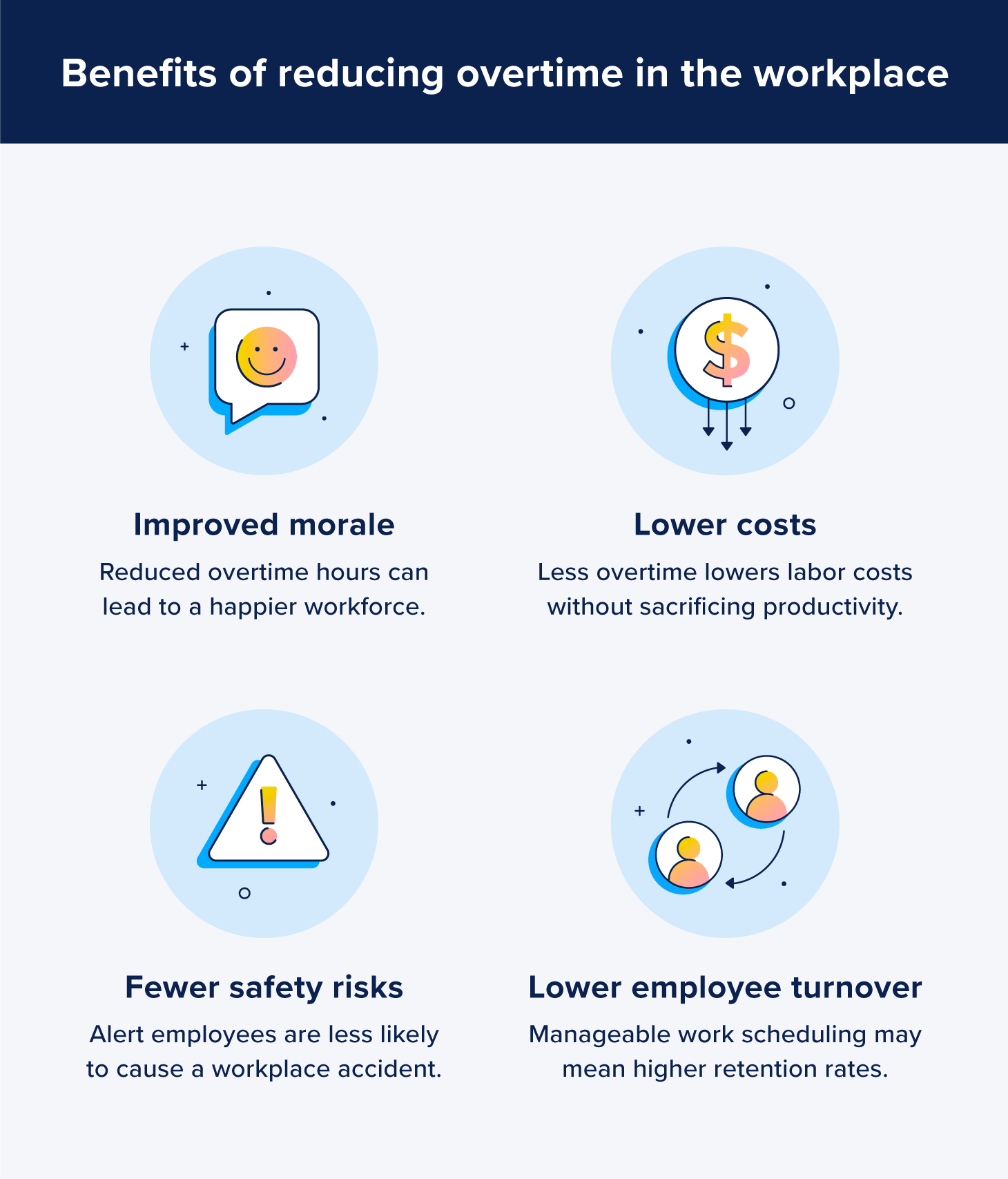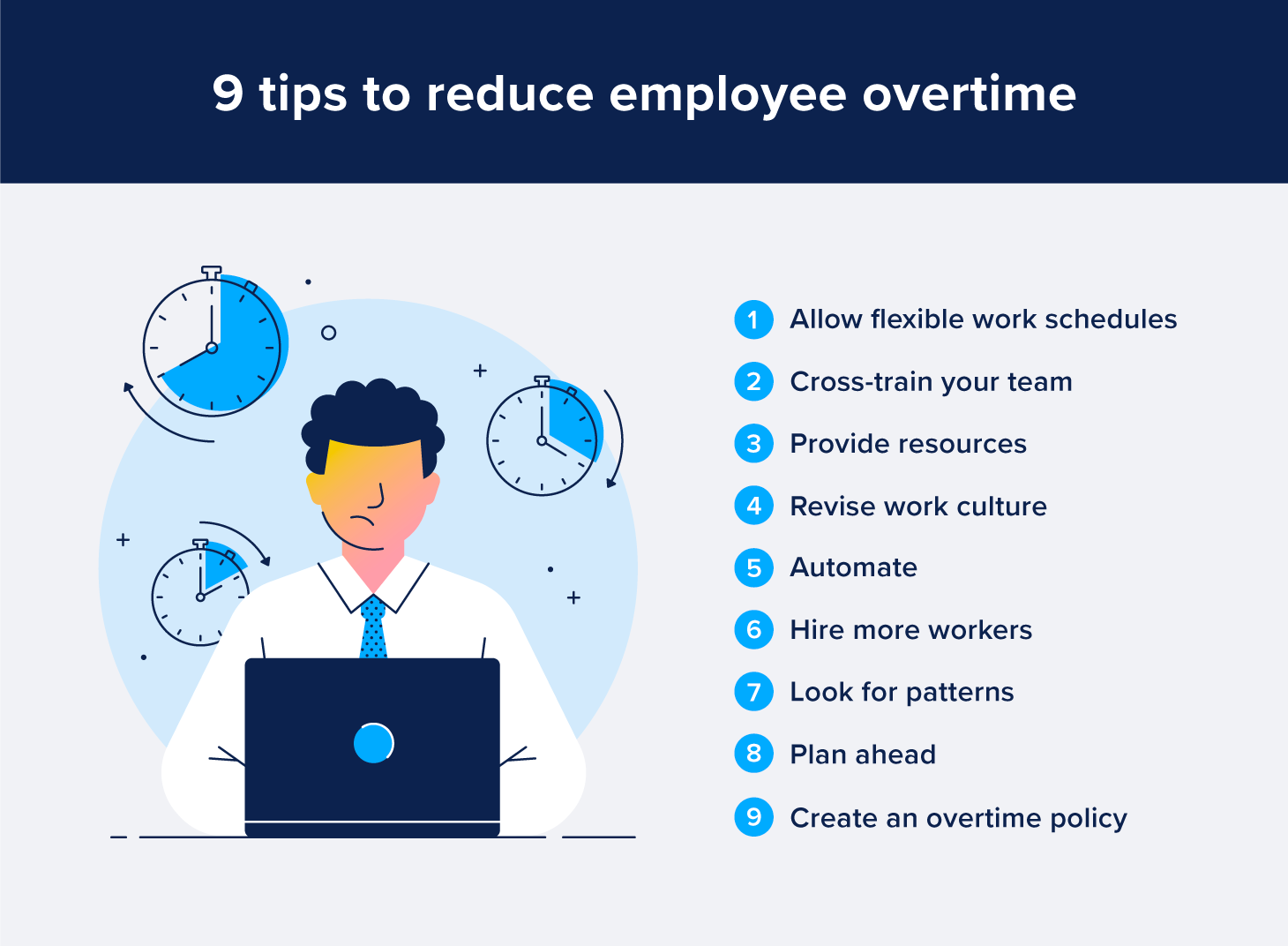9 Effective Tips To Reduce Employee Overtime

Excessive overtime costs a business money, and its employees their productivity.
Contrary to popular belief, just because employees are working longer hours doesn’t mean that they maintain efficiency — in fact, some of the most productive countries in the world are those in which employees work the least. Any company that relies on more than 40-hour weeks from its employees should be thinking seriously about how to reduce overtime in its operations.
That’s where we come in. Be it a complete employee management system or simple planning and automation, here are nine effective tips to reduce employee overtime. Read on to maximize your workforce without sacrificing efficiency, and improve your bottom line in the process.
Why is it important to reduce overtime?
It’s important for a business to reduce overtime because it adds additional costs without additional efficiency.
Employees who work more than 50 hours a week are doing so inefficiently, and that can be seen not just in the scope of the individual but in the country as well. Research compiled by Expert Market via sources such as the OECD and World Data Bank found that the most productive countries worldwide — countries like Ireland, Norway, and Germany — are those in which employees work the least amount of hours.
Conversely, the countries in which employees work the most hours — such as Mexico, Chile, and Greece — are those that are deemed least productive. Despite having one of the highest GDPs per capita, the United States comes in as 11th most productive due to the high level of hours worked per employee.
All of this builds a strong argument for reducing overtime in the workplace, and doing so can make a difference in a few key areas:
- Improved morale: It’s no secret that employees who are frequently overworked have lower morale than those who work traditional 40-hour weeks. Reduced hours can lead to a happier work environment.
- Lower costs: When employers reduce the amount of overtime, they are saving money by not paying inflated overtime hourly rates. Considering the steep drop-off in productivity when employees work more than 48 hours, this is an easy way to reduce expenses.
- Fewer safety risks: Employees who are frequently overworked contribute more to workplace accidents. Having an alert and adequately worked staff leads to more safety in your organization.
- Lower employee turnover: It’s no secret that employees who are frequently overworked are often unhappy with their job. Giving workers a more manageable and predictable schedule can help retention rates.

9 tips to reduce employee overtime
Now that we’ve covered why it’s problematic for a business, we will detail how to address excessive overtime. Use these tips to reduce employee overtime in your operations and gain a happier, more productive workforce.
1. Allow flexible work schedules
In the 2021 Gartner Digital Worker Experience Survey, 43% of surveyed employees answered that flexible work schedules allowed them to achieve greater productivity. Therefore, an easy way to deal with excess overtime is to implement flexible work schedules for your staff.
If your business is more of a white-collar, task-oriented operation, letting your employees choose how and when they work can cut down on the time they spend in the office. By shifting from an “hours worked” expectation to a “tasks completed” expectation, workers can be more productive and use their time more efficiently.
If your business involves shift work or other labor-focused activities, being creative with scheduling can make a big difference. Enlist the help of an all-in-one employee management tool to easily create schedules, stay on top of hours worked, and stop overtime scheduling problems before they start. This method can also help reinforce proper time clock rules to ensure paychecks and hours worked are always accounted for correctly.

2. Cross-train your team
More often than not, a handful of key employees are the ones that accrue most of the overtime hours. These workers have a combination of skills that are nearly indispensable, leaving these individuals to take on heavy workloads and long hours. Combat this trend by cross-training all members of your team.
Cross-training your team benefits your business in a few key areas. Employees who are cross-trained will gain a boost in morale because they see their company believing in their abilities and investing in their future. Additionally, these newly cross-trained workers will be able to assist the key employees, leading to better work coverage. Investing in your team is a great way to reduce payroll costs.
3. Give your team the proper resources
Whenever possible, investing in resources and productivity tools can make a big difference in reducing employee overtime hours. To start, take some time to do an organizational audit and keep in mind that resources can come in two different areas.
Is there a tool — be it a software or physical piece of equipment — that could help reduce the time it takes to complete a certain task? Or maybe, similar to our tip above, there are resources in the form of education and cross-training that could help a workforce become more productive. In either case, a more productive team means tasks get completed faster, and overtime hours are reduced.
4. Revise your work culture
Overtime can become ingrained in a business culture, leading to long hours, unproductive work, and high employee turnover. Sometimes extra work is inevitable, but by making overtime the exception and not the rule, workers won’t feel pressured to stay on the clock to keep up appearances.
Set clear expectations for overtime that are followed by every level of employee in the organization. This can cause a top-to-bottom culture shift, which will keep extra hours at a minimum and employee morale high. Then when rare overtime work is necessary — such as scheduling employees on the weekends — the hours will be utilized efficiently.
5. Automate whenever possible
Similar to giving your team the proper resources, automating job functions whenever possible can lead to a more efficient workforce.
Are there tools that can improve efficiencies for day-to-day tasks? Maybe outdated software is costing your employees 15-30 minutes daily — investing in new systems could cut down on that wasted time. Or maybe your employees are being inundated with emails — finding a way to automate can keep your workers focused on more important tasks.
Automation can create more time for your employees to focus on work that adds the most value to your business while keeping them from staying late.
6. Hire more workers
It may seem counterintuitive, but one of the simplest ways to reduce expenses and employee overtime is to hire more workers.
At first glance, business owners may feel as though it’s not in the budget to hire more help. However, if your staff is consistently putting in overtime hours, hiring more employees can reduce or eliminate overtime wages, which can turn out to be a net positive for your balance sheet.
Plus, hiring more help doesn’t need to be on a full-time basis. If there’s a time of the year that’s busier than others, think about hiring seasonal employees. If there are certain times of the day that overwhelm employees, think about hiring part-time help. Being creative with new hire work schedules can reduce overtime across the board.
7. Look for patterns
When trying to reduce employee overtime, look for patterns in operations that could be improved or supplemented. Similar to our previous tips, there are a few key areas to begin looking for opportunities.
Is there a menial task or common situation that consistently results in more overtime hours? Consider investing in tools to help your employees, or find ways to save time with automation. Is there a time of the year or time of the week that always leaves employees working late? Consider hiring more help, even on a part-time or seasonal basis.
There are more variables than just these scenarios, and taking a hard look at your operations to find patterns can be a great way to save your business money.
8. Plan ahead
Looking ahead a few weeks or months in operations can give your business a chance to support employees in a way that reduces overtime hours.
Is there a busy time period coming up in the near future? In addition to hiring seasonal help, maybe there are tools you can invest in to ease or support your employees during that time. In labor- and service-based industries, there may be a period coming up with more appointments than usual, so planning ahead with creative employee scheduling may be appropriate.
Planning ahead lets your business be prepared for more work before it hits, helping to reduce employee overtime.
9. Create an overtime policy
Finally, setting an overtime cap or other such policy will instantly reduce employee hours and inflated paychecks. If there’s a hard limit for how much employees can work, there will be no risk of excessive overtime.
That being said, it’s important to factor in the steps above. Setting an overtime policy doesn’t magically solve overtime management issues, and needs to be complemented with other initiatives. Before doing so, make sure your employees are supplemented with tools and automation, and always look ahead to account for busy periods and hire extra help when needed. If done correctly, creating an overtime policy can reduce excess hours and any timesheet errors.

Additional overtime FAQs
Now that we’ve covered nine ways to reduce overtime, we will detail a few more common questions regarding overtime.
What are the causes of overtime?
Consistent employee overtime can manifest in a variety of ways.
One common reason is that employees are not adequately supported. Be it outdated processes and tools or a lack of staffing, employees who are bogged down by menial tasks or desperately need help can easily accrue hefty overtime hours. Additionally, businesses may have a flawed culture, promoting that hard work means staying late — when in reality, there is no basis to those claims.
How do you tell employees to reduce overtime?
Before you tell your employees to reduce their overtime hours, make sure they are adequately supported.
First, ensure that they have everything they need in terms of tools and automation. Make sure they aren’t overwhelmed with their duties, and you’re offering them proper support and scheduling processes. If those are fulfilled and an employee is still taking unnecessary overtime, schedule a meeting with them.
Get to the bottom of why they’re taking overtime. Maybe they need to be cross-trained, or perhaps they will alert you to a productivity issue that had not been previously considered. Review any overtime policies you have with them, and be ready to support them if a previously unknown workplace issue comes up.
At the end of the day, employee overtime is an issue that can easily be remedied. Whether that means hiring additional employees, automating menial tasks, or anything else to fully support your team, our steps above can help you reduce or eliminate overtime hours in your organization.
Of course, the easiest way to stay on top of employee overtime is with a full-service employee management tool like we offer at ZoomShift. Stay on top of scheduling, manage PTO and time off requests, and keep track of hours worked to make your job easier and reduce overtime across the board.
JD enjoys teaching people how to use ZoomShift to save time spent on scheduling. He’s curious, likes learning new things everyday and playing the guitar (although it’s a work in progress).



